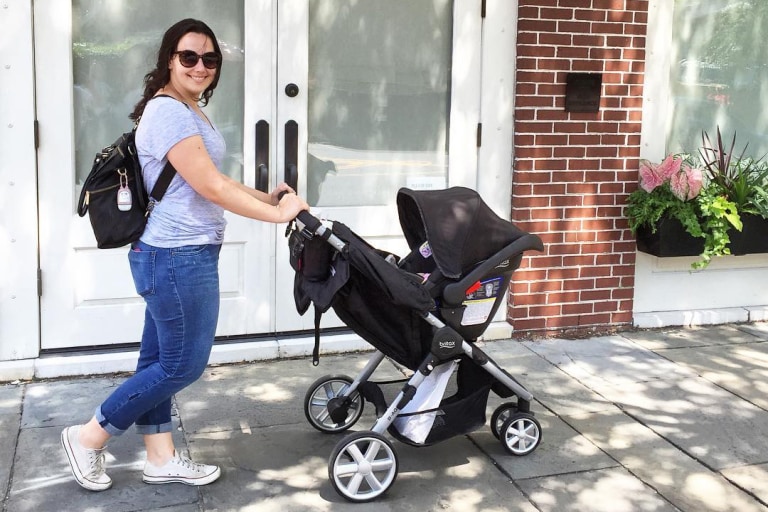October 24, 2023
How to Choose a Travel System
Want your car seat to clip into your stroller? Here’s what you to know about travel systems.
By now, you may have heard someone mention something about a travel system for newborns and wondered, “What the heck is that?”
It sounds like something that beams your baby from here to there, but rest assured there’s no space-tech involved. It’s an infant car seat that attaches to a traditional stroller, and it has some major benefits.
What are the Benefits of a Travel System?
First, it lets you move your baby from car to stroller—and vice versa—without waking them up (because some babies love to nod off in the car).
A travel system also allows you to stroll with your baby from day one. Regular, sit-up strollers won’t work for newborns since they don’t have head and neck control and end up slumping over.
The only strollers that work for newborns are ones that:
- Recline to a completely flat surface
- Have a bassinet (like an old-fashioned buggy or fancy pram stroller)
- Allow you to attach an infant car seat (like in a travel system)
Another thing: buying an infant car seat and stroller set as one purchase typically saves you $60 to $100. The trick is to make sure you love both the stroller and the car seat that come together.
Your child will likely outgrow the infant car seat at around 10-14 months, at which point you might consider switching over to an infant to toddler car seat that stays installed in the car. But you can use the stroller through toddlerhood.
Do You Need a Travel System?
Travel systems are super convenient. But there are other options for getting around with a newborn, such as:
- Stroller frame: This has the basic structure of a stroller, minus the seat. A stroller frame is designed for the singular job of wheeling around your infant car seat. They’re typically inexpensive but stop being useful once your baby outgrows the infant car seat at about a year old. (Whereas with a travel system, your baby transitions to the regular stroller seat.)
- Baby carrier: You can wear your baby in a carrier or wrap and not use the stroller at all until your baby gets old enough to sit up. If you’re strong and don’t get back pain easily, this could be a great option. But you’ll have to move your sleeping baby from the car seat to the carrier.
- A regular stroller with a car seat adapter: Many full-size strollers have car seat adapters you can purchase so you can clip an infant car seat onto it. You’ll need to make sure the car seat and stroller you want are compatible, however.
Note: Lightweight strollers typically can’t support the weight of an infant car seat. That means that most strollers included in a travel system, and strollers that adapt to hold a car seat, are on the heavier side.
What Should You Look for in the Stroller?
Between the two items in a travel system, the stroller is what you’ll use the longest. There are several factors that can help you determine if it’s a good fit for you and your family, such as:
- Size and weight: This will affect how easy it is to load in your trunk, take on public transportation, get through narrow passageways or up the stairs in your apartment.
- Type of terrain it can handle: Some strollers only push well on paved surfaces while others are designed to handle bumpier routes.
- Ease of use: This is key to loving (or not loving) your stroller. It includes things like how easily the stroller opens and closes, how compact it is when folded and if the seat cover is washable.
- Convenient features and accessories: This includes thoughtful extras like adjustable handlebars and a large storage basket and sun canopy, or helpful add-ons such as snack trays and cup holders.
- Price: You can get a good travel system—with a stroller that will last awhile—for not a lot of money (the Graco Modes 3 Lite, for example). Or you can splurge and get all the bells and whistles (such as Nuna’s Tavo & Pipa lite LX Travel System). It’s up to you and your family’s budget.
Learn more about how to choose a stroller.
What Should You Look for in the Car Seat?
All new car seats must adhere to the same federal safety regulations. Some car seats may have additional features that go above and beyond what’s required by law. After safety, the biggest consideration is usually weight, since carrying a baby around in a car seat can take a toll on your arms. Most infant car seats weigh 10 lbs or less, but when you put a baby in there, the weight adds up!
Learn more about how to choose a car seat and see our guide to the Best Infant Car Seats.
Choosing What’s Right for You
Although it can take some research to figure out what travel system is going to make you and your baby happiest, it’s worth it to find a set you love. Being able to transfer your baby from one mode of transportation to another without waking them up is pretty great. Not to mention being able to get out and about with your new baby!
Babylist Staff
Editor
Babylist editors and writers are parents themselves and have years of experience writing and researching, coming from media outlets like Motherly, the SF Chronicle, the New York Times and the Daily Beast, and the fields of early childhood education and publishing. We research and test hundreds of products, survey real Babylist parents and consult reviews in order to recommend the best products and gear for your growing family.

